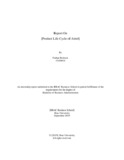| dc.contributor.advisor | Mamoon, Mahreen | |
| dc.contributor.author | Redwan, Farhan | |
| dc.date.accessioned | 2020-02-06T04:23:11Z | |
| dc.date.available | 2020-02-06T04:23:11Z | |
| dc.date.copyright | 2019 | |
| dc.date.issued | 2019-09 | |
| dc.identifier.other | ID 15104014 | |
| dc.identifier.uri | http://hdl.handle.net/10361/13742 | |
| dc.description | This internship report is submitted in partial fulfillment of the requirements for the degree of Bachelor of Business Administration, 2019. | en_US |
| dc.description | Cataloged from PDF version of internship report. | |
| dc.description | Includes bibliographical references (page 24). | |
| dc.description.abstract | Robi Axiata Limited (Robi) is a subsidiary company of Axiata group It is a joint venture between Axiata Group Berhad of Malaysia, Bharti Airtel Limited of India and NTT DoCoMo Inc. of Japan. Axiata holds 68.7% controlling stake in the entity, Bharti holds 25% while the remaining 6.3% is held by NTT DOCOMO of Japan. Robi being the second largest network operator operating in Bangladesh just behind Grameenphone. Moreover, the report entails about the 12 weeks of working period of understanding the product lifecycle of Airtel. To add, I worked at the Airtel voice unit, which is the main operational unit of market operations how it works and my work responsibilities during my tenure. The report took in to consideration of the whole networking community of Bangladesh. Grameenphone is the market leader, and the biggest competitor of Robi, with the vision of becoming the leader of telecommunication service provider in Bangladesh is striving to get to the level of Grameenphone. However, the report is mainly done to give the idea of the product life cycle of Airtel which is a part of Robi now, having the benefit of market position staying with Robi. The report will entail with chapter 1 which starts with organizational overview, then will talk about the products, will give brief idea of the management team of Robi. Then the chapter 2 will talk about the divisions and market operations unit of Robi and the SWOT analysis. To add, then the report part starts that is chapter 3 having rationale of the study, limitations of the study, scope and delimitation of the study, objective of the study, research question, role during internship and the literature review. The chapter 4 entails about the product lifecycle with it’s several parts detailing about the products going through several stages before finally being launched. The 5th chapter entails the USSD and the daily voice tracker this chapter mainly gives an insights about the revenue generation and the USSD channel check. Moreover, the sixth chapter mainly talks about the experience in networking company and the recent talk between Telenor and Axiata in coming to operate together. In the last chapter of the report, there will be recommendation and conclusion which will finally give an end of the report. However, I tried to finish the report with any unwanted mistakes if there is any please go through with kindness. | en_US |
| dc.description.statementofresponsibility | Farhan Redwan | |
| dc.format.extent | 24 pages | |
| dc.language.iso | en | en_US |
| dc.publisher | Brac University | en_US |
| dc.rights | Brac University Internship reports are protected by copyright. They may be viewed from this source for any purpose, but reproduction or distribution in any format is prohibited without written permission. | |
| dc.subject | Robi Axiata Limited | en_US |
| dc.subject | Product life cycle | en_US |
| dc.subject | Airtel | en_US |
| dc.subject.lcsh | Telecommunication--Bangladesh. | |
| dc.title | Product life cycle management of Airtel | en_US |
| dc.type | Internship report | en_US |
| dc.contributor.department | Brac Business School, Brac University | |
| dc.description.degree | B. Business Administration | |

